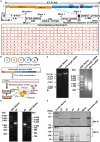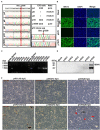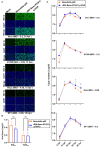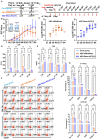Establishment and Cross-Protection Efficacy of a Recombinant Avian Gammacoronavirus Infectious Bronchitis Virus Harboring a Chimeric S1 Subunit
- PMID: 35935229
- PMCID: PMC9354458
- DOI: 10.3389/fmicb.2022.897560
Establishment and Cross-Protection Efficacy of a Recombinant Avian Gammacoronavirus Infectious Bronchitis Virus Harboring a Chimeric S1 Subunit
Abstract
Infectious bronchitis virus (IBV) is a gammacoronavirus that causes a highly contagious disease in chickens and seriously endangers the poultry industry. A diversity of serotypes and genotypes of IBV have been identified worldwide, and the currently available vaccines do not cross-protect. In the present study, an efficient reverse genetics technology based on Beaudette-p65 has been used to construct a recombinant IBV, rIBV-Beaudette-KC(S1), by replacing the nucleotides 21,704-22,411 with the corresponding sequence from an isolate of QX-like genotype KC strain. Continuous passage of this recombinant virus in chicken embryos resulted in the accumulation of two point mutations (G21556C and C22077T) in the S1 region. Further studies showed that the T248S (G21556C) substitution may be essential for the adaptation of the recombinant virus to cell culture. Immunization of chicks with the recombinant IBV elicited strong antibody responses and showed high cross-protection against challenges with virulent M41 and a QX-like genotype IBV. This study reveals the potential of developing rIBV-Beau-KC(S1) as a cell-based vaccine with a broad protective immunity against two different genotypes of IBV.
Keywords: IBV; broad-spectrum protection; cell adaptability; growth characteristics; immunization; reverse genetics.
Copyright © 2022 Ting, Xiang, Liu and Chen.
Conflict of interest statement
The authors declare that the research was conducted in the absence of any commercial or financial relationships that could be construed as a potential conflict of interest.
Figures






Similar articles
-
The spike protein of the apathogenic Beaudette strain of avian coronavirus can elicit a protective immune response against a virulent M41 challenge.PLoS One. 2024 Jan 24;19(1):e0297516. doi: 10.1371/journal.pone.0297516. eCollection 2024. PLoS One. 2024. PMID: 38265985 Free PMC article.
-
The S2 Subunit of Infectious Bronchitis Virus Beaudette Is a Determinant of Cellular Tropism.J Virol. 2018 Sep 12;92(19):e01044-18. doi: 10.1128/JVI.01044-18. Print 2018 Oct 1. J Virol. 2018. PMID: 30021894 Free PMC article.
-
Recombinant live attenuated avian coronavirus vaccines with deletions in the accessory genes 3ab and/or 5ab protect against infectious bronchitis in chickens.Vaccine. 2018 Feb 14;36(8):1085-1092. doi: 10.1016/j.vaccine.2018.01.017. Vaccine. 2018. PMID: 29366709 Free PMC article.
-
Development and characterization of a recombinant infectious bronchitis virus expressing the ectodomain region of S1 gene of H120 strain.Appl Microbiol Biotechnol. 2014 Feb;98(4):1727-35. doi: 10.1007/s00253-013-5352-5. Epub 2013 Nov 28. Appl Microbiol Biotechnol. 2014. PMID: 24287931
-
Avian infectious bronchitis virus.Rev Sci Tech. 2000 Aug;19(2):493-508. doi: 10.20506/rst.19.2.1228. Rev Sci Tech. 2000. PMID: 10935276 Review.
Cited by
-
Rapid development of attenuated IBV vaccine candidates through a versatile backbone applicable to variants.NPJ Vaccines. 2025 Mar 28;10(1):60. doi: 10.1038/s41541-025-01114-z. NPJ Vaccines. 2025. PMID: 40155419 Free PMC article.
-
Antiviral Drug Discovery.Int J Mol Sci. 2024 Jul 6;25(13):7413. doi: 10.3390/ijms25137413. Int J Mol Sci. 2024. PMID: 39000520 Free PMC article.
-
Prevalence, Genotype Diversity, and Distinct Pathogenicity of 205 Gammacoronavirus Infectious Bronchitis Virus Isolates in China during 2019-2023.Viruses. 2024 Jun 7;16(6):930. doi: 10.3390/v16060930. Viruses. 2024. PMID: 38932222 Free PMC article.
-
Current Status of Poultry Recombinant Virus Vector Vaccine Development.Vaccines (Basel). 2024 Jun 6;12(6):630. doi: 10.3390/vaccines12060630. Vaccines (Basel). 2024. PMID: 38932359 Free PMC article. Review.
-
Baicalin Protects Broilers against Avian Coronavirus Infection via Regulating Respiratory Tract Microbiota and Amino Acid Metabolism.Int J Mol Sci. 2024 Feb 9;25(4):2109. doi: 10.3390/ijms25042109. Int J Mol Sci. 2024. PMID: 38396786 Free PMC article.
References
LinkOut - more resources
Full Text Sources

